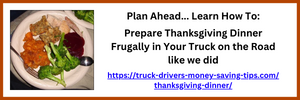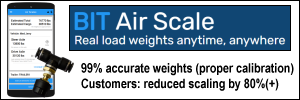By: Lorraine Richardson,
CNM Communtiy College Truck Driving student, Albuquerque, NM
 What does “follow your tandems” mean in regards to alley docking?
What does “follow your tandems” mean in regards to alley docking?
—–
Response from Vicki:
Hello, Lorraine,
Thanks for asking a question about following one’s tandems when backing up a truck, one of the most difficult truck operations to master.
When my husband Mike and I were in truck driver training school, one of the instructors gave some trite and inaccurate advice about how to get a trailer backed into a dock (or in the case of the school, very close to the backboard).
He had some ridiculous “formula” about so much of a turn of the steering wheel to the left, so much to the right and supposedly, one was “in”.
Well, in real life, backing a truck can be a little different each time because of
– changes in where the tandems are set under the trailer,
– the wheelbase of the tractor,
– how the dock is configured and
– other factors.
I referred on two pages of our site — CDL Road Test and Safely Back Up — to the advice given by the instructor that actually made sense and worked: [“Follow your tandems; they’ll never lead you wrong.”]
Quoting the CDL Road Test page:
—–
By that, he meant that a driver needs to angle his or her truck based on the position of the trailer’s tandem tires. (To those of you who have been driving a truck for a long time, this seems so commonsense, but to newbies like we were, it was news.)
Part of the trick of doing a 90-degree alley docking is knowing at what point the rear of the trailer will meet the dock. One does not want to ram the dock! For someone who is not familiar with the length of a commercial trailer, knowing when to stop backing can be difficult. He or she knows the backboard (which is set up to resemble the dock) is back there, but how far “back there” is it?
—–
In case that explanation didn’t make sense, when one is backing an articulating vehicle (like a tractor with a single trailer behind it is), the trailer tandems will always tell you where the trailer is going. The angle of the steer tires and the the distance from the steer tires to the kingpin both play a part in where the tandems go.
On our Safe Driving page, under “Safe Driving: Backing Up”, check out the “tandem position” illustration I drew. I wrote:
—–
The position of the tandems under the trailer have a great deal to do with how tightly a turn can be made. Examine the following illustration, which has been created to show the differences in turning radius between two trailers whose tandems are set differently:
– the “trailer” on the left has its tandems set all the way at the rear but
– the “trailer” on the right has its tandems pulled forward.
The lengths and angles of the two lines are the same; only the point at which the lines intersect has changed. The numbers shown on the horizontal lines are in pixels, just for comparative purposes.
Both trailers swing about their pivots. The driver whose trailer has tandems all the way at the rear will always know where the rear of his trailer is as he backs into a spot; however, there may not be the forward space required to make the turn. Alternatively, the driver whose trailer has tandems pulled forward must be certain to clear objects on his right-hand (blind) side because of the pivot point.
—–
I hope that that makes sense to you. When you get into a truck and start doing backing, I think you’ll get a better feel for following your tandems.
I wish you great success in completing your schooling and becoming a truck driver. Please let us know how it goes for you. I encourage you to return to this page and comment about how what I wrote benefited you.
As you drive professionally, my husband Mike and I wish you safe travels and lots of money saving opportunities on the road.
Best regards,
Vicki Simons












